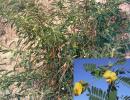
|
Sesbania sesban
Scientific name:
Sesbania sesban
Order/Family:
Fabaceae
Local names:
English River Bean or Egyptian rattle pod
Kenya: Daisa (Boran), Kinuka muhondo (Giriama), Munyongo (Kamba), Natiantia (Keiyo), Mwethia (Kikuyu), Omosabisabi (Kisii), Chisubasubi (Luhya or Bukusu), Kumusubasubi or Lukhule (Luhya), Oyieko or Siaya or Sawo sawo (Luo), Oloiyangalni (Maasai), Walbaiyondet (Nandi), Loiyangalani (Samburu), Ethiopia:Girangire (Amargna), Enchini or Harcha (Oromugna), Rakile lo'od or Get beyo (Sidamigna), Tetem agazen or Shashata (Tigrigna) |
Distribution
Geographical distribution
|
|
One of many useful African Sesbania more species of the type which survive waterlogging and fix nitrogen. Naturally distributed from Senegal to Somalia and South Africa. Cultivated throughout tropical Africa and Asia. It is found at the margin of fresh-water lakes and seasonal ponds. Some types tolerate acid and saline soild. Easy to establish even in waterlogged soil and dry eroded soil. In Ethiopia, it performs well in Moist and Wet Bereha, Kolla and Weyna Dega agroclimatic zones of Afar plains and in nearly all ohter regions, 300 - 2000 m.
Widely used in western Kenya, it is distributed in the country as above;
General Information about the Tree:
This tree has a great potential for soil improvement on small farms due to nitrogen fixation and leaf mulch.
Biophysical Limits:
Altitude ranges from 100 to 2300 m, Mean annual temperatures (10 degrees on the lower side and 45 degrees on the upper side, Mean annual rainfall: 500-2000 mm, Soil type: It is capable of putting up with seasonal or permanently waterlogged soils as well as saline, acidic and alkaline soils.
It is common along rivers and in Kenya, is found on the shores of fresh water lakes like Naivasha and Baringo and in seasonal swamps. It is widely cultivated in western Kenya and does well in agro-ecological zones I - IV
Description
| A deciduous, short-lived shrub or tree to 8 m. Bark: Red-brown, young shoots hairy. Leaves: Compund to 12 cm long, 12 - 25 pairs of leaflets, each leaflet to 2 cm oblong, tip notched, narrow. Flowers: Pale yellow, speckled maroon, in few-flowered sprays to 15 cm long. Fruit: Abundant bunches of think pale brown pods to 20 cm, with separated sections so seeds rattle within. |
|
Uses and Propagation
| Uses:
Firewood, poles, medicine (ground leaves), fodder (leaves), shade (young coffee), mulch, nitrogen fixation, soil improvement, soil conservation, fibres (young stems), soap (leaves). Propagation and Tree Management: Propagation may be done by direct sowing at site or wilding. One of the major advantages of sesbania over other forage trees and shrubs is its fast early growth rate, which can be exploited by intercropping it with other slower establishing species for earlier yields. This tree species has been reported to attain a height of 4-5 m in 6 months. It also does well under repeated cuttings and coppices readily, with many branches arising from the main stem below cutting height. Cutting frequencies are generally 3-4 cuts per year, but up to 8 cuts are made in some areas. Yields also vary from 4 to 12 t/ha dry matter per year, depending on location of cultivation.
Cutting height can also determine yield, with cutting heights of 50-76 cm being good for plant survival and productivity.
Seed storage behaviour is customary and their viability can be maintained for 2 years in open storage at room temperature. The Sesbania species may occur in dense stands; agroforestry (mixed farming system); and conservation. Pruning and short rotation is employed in their management for optimum productivity.
Products:
Services:
Seed:
The species is a prolific seeder with a high germination rate. About 110'000 seed per kg. Germination about 80%. Treatment: Not necessary for fresh seed, soak stored seed in cold or tepid water for 24 hours before sowing. Storage: Seed can be stored for long periods if kept in a cool and dry place, but best germination from fresh seed. |
|
Remarks:
The species may harbour root-knot nematodes. The genetic diversity of Sesbania types allows for selection (e.g. for different uses, management, soil types). The leaf mulch and nitrogen-fixation features make this a tree of great potential for intercropping and thereby soil improvement on small farms.Pests and Diseases
It is susceptible to attacks by nematode, insect, fungi and virus. The leaf-eating beetle Mesoplatys ochroptera can completely defoliate this tree killing it. It can also be attacked by caterpillars, hymenoptera, and stem borers. Some potentially destructive root-knot nematodes have also been recorded as associated with this tree.
Due to their ability to harbor rootknot nematodes, they should be avoided in combination with crops that are very sensitive to nematodes like banana & Irish potatoes.
Information Source Links
- Bekele-Tesemma, B. (2007). Useful trees and shrubs for Ethiopia. World Agroforestry Centre, Nairobi, Kenya. ISBN 92-9059-2125
www.worldagroforestry.org - Maundu, P. and Tengnäs, B. (2005). Useful trees and shrubs for Kenya. World Agroforestry Centre. ISBN: 9966-896-70-8
www.worldagroforestry.org - Heering, J.H. and Gutteridge, R.C. (1992) Sesbania sesban (L.) Merrill. In:'t Mannetje, L. and Jones, R.M. (eds) Plant Resources of South-East Asia No. 4. Forages. pp. 198-200. (Pudoc Scientific Publishers, Wageningen, the Netherlands
- www.worldagroforestrycentre.org

 Back
Back




